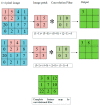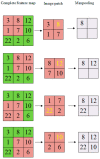SCDet: A Robust Approach for the Detection of Skin Lesions
- PMID: 37296686
- PMCID: PMC10253111
- DOI: 10.3390/diagnostics13111824
SCDet: A Robust Approach for the Detection of Skin Lesions
Abstract
Red, blue, white, pink, or black spots with irregular borders and small lesions on the skin are known as skin cancer that is categorized into two types: benign and malignant. Skin cancer can lead to death in advanced stages, however, early detection can increase the chances of survival of skin cancer patients. There exist several approaches developed by researchers to identify skin cancer at an early stage, however, they may fail to detect the tiniest tumours. Therefore, we propose a robust method for the diagnosis of skin cancer, namely SCDet, based on a convolutional neural network (CNN) having 32 layers for the detection of skin lesions. The images, having a size of 227 × 227, are fed to the image input layer, and then pair of convolution layers is utilized to withdraw the hidden patterns of the skin lesions for training. After that, batch normalization and ReLU layers are used. The performance of our proposed SCDet is computed using the evaluation matrices: precision 99.2%; recall 100%; sensitivity 100%; specificity 99.20%; and accuracy 99.6%. Moreover, the proposed technique is compared with the pre-trained models, i.e., VGG16, AlexNet, and SqueezeNet and it is observed that SCDet provides higher accuracy than these pre-trained models and identifies the tiniest skin tumours with maximum precision. Furthermore, our proposed model is faster than the pre-trained model as the depth of its architecture is not too high as compared to pre-trained models such as ResNet50. Additionally, our proposed model consumes fewer resources during training; therefore, it is better in terms of computational cost than the pre-trained models for the detection of skin lesions.
Keywords: batch normalization; benign; convolution neural network; dermoscopic images; malignant; max pooling; skin cancer; skin lesion; softmax.
Conflict of interest statement
The authors state that they have no conflict of interest.
Figures














References
-
- Latif J., Xiao C., Imran A., Tu S. Medical Imaging using Machine Learning and Deep Learning Algorithms: A Review; Proceedings of the 2019 IEEE International Conference on Big Data (Big Data); Sukkur, Pakistan. 30–31 January 2019; pp. 1–5. - DOI
-
- Zemouri R., Zerhouni N., Racoceanu D. Deep Learning in the Biomedical Applications: Recent and Future Status. Appl. Sci. 2019;9:1526. doi: 10.3390/app9081526. - DOI
-
- Pardo A., Streeter S.S., Maloney B.W., Gutierrez-Gutierrez J.A., McClatchy D.M., Wells W.A., Paulsen K.D., Lopez-Higuera J.M., Pogue B.W., Conde O.M. Modeling and Synthesis of Breast Cancer Optical Property Signatures With Generative Models. IEEE Trans. Med. Imaging. 2021;40:1687–1701. doi: 10.1109/TMI.2021.3064464. - DOI - PMC - PubMed
LinkOut - more resources
Full Text Sources

